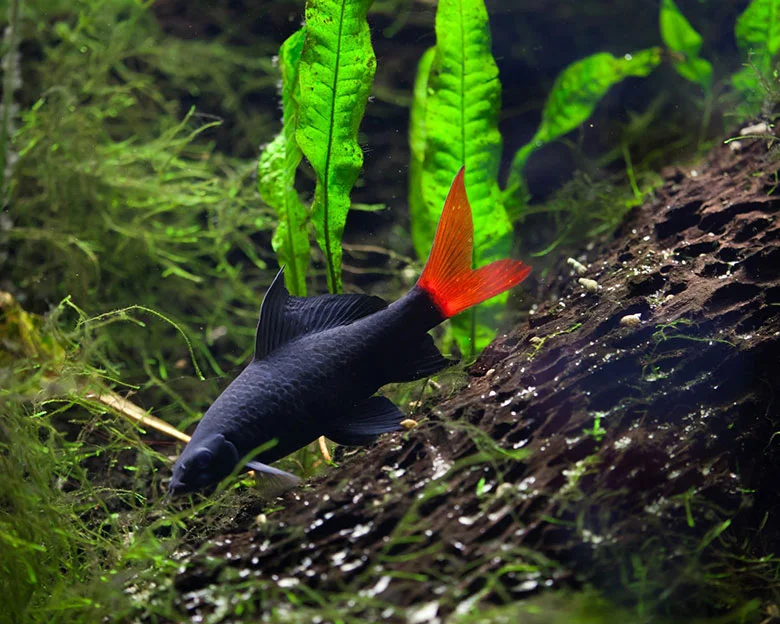Are you looking for a stunning addition to your aquarium that will captivate your attention? Look no further than the Red-Tailed Shark. With their striking black bodies and vibrant red tails, these fish are a beautiful sight to behold.
But don’t be fooled by their beauty – they are also known for their semi-aggressive to aggressive behavior towards other fish.
To properly care for Red-Tailed Sharks, you’ll need to provide a minimum of 40 gallons of tank space and a medium level of care. As solitary creatures, they forage for food on the substrate and cannot be kept with more than one of their kind in a tank.
It’s important to carefully select tank mates, such as tiger barbs or African cichlids, that are suitable for their aggressive tendencies. As an experienced aquarium keeper and enthusiast, I urge you to avoid placing cichlids that are too big to swallow in the same tank as your Red-Tailed Shark.
With the right care and setup, these aggressive beauties can thrive in your aquarium and add a stunning element to your underwater world.
Key Takeaways
- Red-tailed sharks are striking fish with black bodies and vibrant red tails.
- They can be semi-aggressive to aggressive towards other fish and need a minimum of 40 gallons of tank space.
- They are solitary creatures and cannot be kept with more than one of their kind.
- Tank mates must be carefully selected to avoid conflicts, and suitable substrate includes sand or smooth gravel.
About Red-Tailed Sharks

You should know that red-tailed sharks are a semi-aggressive to aggressive species that can’t be kept with more than one of their kind in a tank.
They are also known for their coal black bodies with bright red tails, slim-bodied with high, triangular dorsal and anal fins. These striking features make them a popular choice for aquarium enthusiasts, but it’s important to understand their behavior before adding them to your tank.
Red-tailed sharks are omnivores and solitary species that scours substrate for food. They’re not picky eaters and can be fed sinking wafers, but they’re known to be territorial and may harass other fish in the tank.
It’s important to provide plenty of hiding places and decor to give them their own space. It’s also recommended to place them with other semi-aggressive or aggressive fish, such as tiger barbs, to avoid any conflicts.
Understanding their feeding habits and behavior is key to ensuring a successful and harmonious aquarium with a red-tailed shark.
Care and Tank Requirements
Setting up a tank for red-tailed sharks requires more than just a few plants and rocks; you’ll need to create a complete underwater world with plenty of hiding places and a suitable substrate. Also be sure to know how to set up a hospital tank if anything happens to any of your fish. These fish require a minimum tank size of 40 gallons with a smooth gravel or sand substrate, and a heated tank to mimic their natural habitat.
When it comes to feeding, red-tailed sharks are omnivores and not picky eaters. However, it is recommended to offer sinking wafers as their main source of food. It’s important to note that they are a solitary species that scours the substrate for food, so you’ll need to ensure that they have plenty of space to themselves and that they aren’t competing for food with other fish in the tank.
| Substrate Options | Pros | Cons |
|---|---|---|
| Sand | Natural look, easy to clean | Can cause harmful bacteria buildup if not cleaned properly |
| Smooth Gravel | Easy to clean, can add color to tank | May be too rough for delicate fish, difficult to clean debris |
| Bare Bottom | Easy to clean, no debris buildup | Not aesthetically pleasing, no natural habitat for fish |
In terms of substrate options, sand and smooth gravel are the most common choices for red-tailed shark tanks. However, it’s important to consider the pros and cons of each option before making a decision. Additionally, while red-tailed sharks are hardy and undemanding, they can be aggressive towards other fish and may stress or harass them to death. Overall, setting up a suitable tank for these beautiful fish requires careful consideration and attention to detail.
Tank Mates
When choosing tank mates for your red-tailed sharks, it’s important to consider their semi-aggressive to aggressive nature and select other fish that can handle their behavior. Here are some options to consider:
- Tiger barbs: These fish are also semi-aggressive, making them a good match for red-tailed sharks. They are active and colorful, adding variety to your tank.
- African cichlids: While some species of cichlids can be too aggressive for red-tailed sharks, there are some African cichlids that can coexist peacefully. Be sure to research which species are compatible before adding them to your tank.
- Clown loaches: These fish are peaceful and can handle the aggressive behavior of red-tailed sharks. However, they require a larger tank and should only be added if you have enough space.
- Avoid timid bottom feeders like corydoras catfish, as they can become stressed or harassed by the sharks.
Remember to always research the temperament and compatibility of any fish you plan to add to your tank, and monitor their behavior closely to ensure a peaceful coexistence.
Author’s Expertise
With the experience of an aquarium keeper and enthusiast, the author’s knowledge on red-tailed shark tank mates is as deep as the ocean. When it comes to selecting tank mates for your red-tailed shark, it is important to note that they are semi-aggressive to aggressive fish. Therefore, it is crucial to choose the right companions for them to avoid any conflicts or harm to other fish in the tank.
To make it easier for you to select the right tank mates, the author has shared their expert opinions on the matter in the table below. It highlights the recommended and not recommended tank mate options for red-tailed sharks, as well as the reasoning behind each recommendation. By following these guidelines and maintaining proper aquarium maintenance, you can ensure a peaceful and thriving environment for your red-tailed shark and its tank mates.
| Recommended Tank Mates | Not Recommended Tank Mates | Reasoning |
|---|---|---|
| Tiger Barbs | Timid bottom feeders like corydoras catfish | Red-tailed sharks may stress or harass them to death |
| African Cichlids | Cichlids too big to swallow the shark | They may harm or eat the shark |
| Clown Loaches (in large tank) | They can coexist peacefully with the shark | |
Note: It is important to research and consider the specific temperament, size, and behavior of each potential tank mate before adding them to your aquarium.
Frequently Asked Questions
Can Red-Tailed Sharks Live With Peaceful Community Fish, Or Do They Need To Be Kept With More Aggressive Tank Mates?
Red-tailed sharks can be kept with peaceful tank mates, but they may exhibit territorial behavior. Proper acclimation and providing ample hiding spots can reduce aggression. Adding tank mates gradually can also help.
What Is The Ideal Water Temperature For Red-Tailed Sharks, And How Should Their Tank Be Heated?
“Keep your red-tailed shark’s tank heated to 75-80°F for optimal health and comfort. Use an aquarium heater and regularly monitor water temperature to avoid fluctuations that can harm your fish.”
Do Red-Tailed Sharks Need A Specific Type Of Lighting In Their Tank, Or Can Any Standard Aquarium Light Be Used?
Red-tailed sharks don’t have specific lighting requirements, but a standard aquarium light is recommended for their tank setup. Aim for 8-10 hours of light per day, and provide plenty of hiding places to reduce stress.
How Often Should Red-Tailed Sharks Be Fed, And What Types Of Food Are Best For Them?
You may be concerned about how often to feed your red-tailed shark, but fear not. Feed them sinking wafers or pellets daily, and supplement with live or frozen food twice a week. Tank size, habitat enrichment, and meeting nutritional requirements are key to their well-being.
Are Red-Tailed Sharks Prone To Any Specific Health Issues Or Diseases, And How Can These Be Prevented Or Treated?
Red-tailed sharks may suffer from diseases such as ich, fin rot, and fungal infections. Preventative measures include maintaining water quality, avoiding overfeeding, and quarantining new fish. Treatment options include medication and isolation.
Create a Thriving Aquarium with a Red-Tailed Shark!
Congratulations, you’re now equipped with the knowledge to care for a red-tailed shark in your aquarium! These fish are not suitable for small tanks and require a minimum of 40 gallons. They are solitary creatures and cannot be kept with more than one of their kind.
When selecting tank mates, choose compatible species like tiger barbs or African cichlids. Red-tailed sharks are like the diamonds of the fish world – beautiful, but not without their sharp edges.
They can be aggressive towards other fish, so it’s important to choose tank mates wisely. If you follow the care and tank requirements outlined in this guide, you’ll be able to enjoy the striking beauty of a red-tailed shark in your tank for years to come.
Happy fishkeeping!

